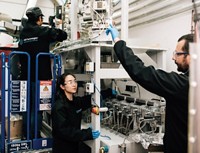Advertisement
Grab your lab coat. Let's get started
Welcome!
Welcome!
Create an account below to get 6 C&EN articles per month, receive newsletters and more - all free.
It seems this is your first time logging in online. Please enter the following information to continue.
As an ACS member you automatically get access to this site. All we need is few more details to create your reading experience.
Not you? Sign in with a different account.
Not you? Sign in with a different account.
ERROR 1
ERROR 1
ERROR 2
ERROR 2
ERROR 2
ERROR 2
ERROR 2
Password and Confirm password must match.
If you have an ACS member number, please enter it here so we can link this account to your membership. (optional)
ERROR 2
ACS values your privacy. By submitting your information, you are gaining access to C&EN and subscribing to our weekly newsletter. We use the information you provide to make your reading experience better, and we will never sell your data to third party members.
Environment
Piercing The Veil Of Creativity
Conference shows that teachable tools, not just serendipity, can stimulate innovation
by Sophie L. Rovner
July 3, 2006
| A version of this story appeared in
Volume 84, Issue 27
At times, creativity and innovation may seem like magic, or at least the province of a select group of particularly imaginative people. A recent program hosted by the Howe School Alliance for Technology Management at Stevens Institute of Technology in Hoboken, N.J., sought to dispel these notions. "There is more of a science to creativity than I would have thought," said Lemuel A. Tarshis, the alliance's director of technology transfer. "It is not mysticism. There is methodology that really works." Tarshis made his remarks last month during the alliance's conference on creativity and innovation.
David Tanner, former head of R&D in DuPont's industrial fibers division, is a strong proponent of innovation-fostering methodology. During his tenure at DuPont, he promoted the use of such techniques to defend the division from severe competitive pressure from Japan and Europe.
DuPont realized that "to build a more innovative organization, we needed to enhance the environment for creative thinking," said Tanner, who is now president of Tanner & Associates in Wellington, Fla. One technique to achieve this kind of cultural change is to give status to the effort. For instance, laboratory unit heads periodically replaced important monthly technical program reviews with creativity workshops. The substitution emphasized the workshops' significance.
Establishing rituals also helps change the culture, Tanner said. At the end of other monthly meetings, the unit head would invite two or three people to speak about their creative work at DuPont. The routine spread the word about creativity and altered perceptions about who could be creative.
Process engineers, for instance, initially felt that "creativity is not for us; it's for the research people," Tanner said. "But when they saw a fellow engineer get up and say 'I came up with an idea and I increased throughput 30-40%,'" the engineers not only came to understand what creative thinking was, but they also wanted to incorporate it into their own work.
Tanner described specific tools to generate ideas and arrive at a novel solution to a problem, including the concept of lateral thinking, in which a "provocation" jolts the mind out of its normal pattern of thought. The provocation is "an idea related to the problem you're tackling, but it makes absolutely no sense," he explained. "It's stupid, impractical."
Techniques to generate a provocation include pulling a random word out of a dictionary and seeing what new ideas it prompts about the problem. Alternatively, those trying to solve the problem can use exaggeration, distortion, and wishful thinking to elicit new modes of thinking. They can also list what they take for granted about the problem and then throw out those assumptions.
Tanner discussed an example in which a continuous flow filter system for Kevlar kept breaking down and causing quality problems. The system relied on an oscillating belt that had more than 70 moving parts. A team of R&D, manufacturing, and engineering staffers came up with the provocation that the moving belt should be stationary. This new mind-set led them to reduce the number of moving parts by 80%. Problem solved.
Another technique employs metaphoric thinking, which generates new ideas and concepts by connecting the problem under consideration to something that occurs in an entirely unrelated system, such as nature.
A DuPont research chemist used this approach to find a better way to dye Nomex fiber, which was used in flame-resistant industrial applications. Because the fiber had a very tight structure, the original dyeing process required swelling agents, which were costly and caused environmental problems, Tanner said. After attending a creativity workshop, the chemist pondered what in nature can be penetrated despite its tight structure. His answer? Earth.
Coal miners gain access to the interior of Earth by digging holes and propping them open. Inspired by this analogy, the chemist added a large organic molecule during manufacturing to prop open the structure of the forming Nomex fiber, enabling dye molecules to squeeze into the fiber in a subsequent step. The improved dyeing process opened up new applications for the fiber including carpets, upholstery, and draperies.
"The essence of creativity is seeing the problem in a new way that makes the solution obvious," noted Christopher M. Barlow, a principal with the Co-Creativity Institute, a consulting firm based in Glen Ellyn, Ill. Take the situation in which a tall boat needs to move past a low bridge. Focusing on the desired result—getting the boat past the bridge—can lead to a truly novel solution, such as the Scandinavian practice of sinking the bridge under the water to let the boat pass, Barlow said.
Arriving at that kind of solution requires a shift in perspective, and it may take the members of an innovation team months to get to that new viewpoint. That being said, when the team members present their breakthrough idea to clients or bosses or investors, "it's like you're from the moon," Barlow warned. The team members shouldn't expect the audience to be able to shift its perspective immediately.
"It's probably as hard to make that shift as it was to think up the idea in the first place," he said. "So part of your job in working with teams is to bring the organization along." Team members can help by discussing interim progress with people in their departments.
Anthony J. Le Storti, executive consultant with Ideatects—a firm based in Doylestown, Pa., that specializes in creativity and leadership—said "creative ideas need as much if not more marketing internal to the company than they're going to need when you try to commercialize them and sell them to consumers. You have to do enough homework to say, 'Here's why we think that there's a market for this.' Give the idea a working title, a proposed product name. Come up with the packaging, do the illustrations. Even better, come up with the prototypes."
Teams may find it useful to solicit input from customers, though focus groups may not be particularly effective for generating major innovations. "The customers may not themselves understand what their problem is" or be able to articulate it in such a setting, Le Storti said. The key is to "get into their minds when they really are feeling the need." Children's Tylenol used to be a sour, crunchy tablet until a psychologist began interviewing kids during an illness or shortly afterward, Le Storti said. When the psychologist asked a little girl what she needed in the way of medicine, she replied, "I don't know what I need, but whatever it is, it should be soft, sweet, and pink." The manufacturer responded by developing a formulation that was soft and melted on the tongue.
Input from a variety of viewpoints—whether provided by customers or members of an in-house team—is key for successful innovation. To ensure that he has a wide range of perspectives, Steven A. Jacobs, president of Bilcare, a pharmaceutical packaging research firm in Phoenixville, Pa., said he likes to hire "people with a very high personal weirdness factor. High-PWF people bring outrageous, bizarre concepts to the table. They are not afraid to disagree with me; they are not afraid to challenge each other."
And when he puts an innovation team together, he likes to include people with little similarity of thought and with high cultural diversity. One team included a person from China, another from Ireland, an analytical chemist, a formulator, an information technician, and Jacobs (who is a pharmacist). "Each of us could play off the others," he said. "No one had the same skill sets."
Different teams have different styles. When Jacobs worked at McNeil Consumer & Specialty Pharmaceuticals, a Johnson & Johnson company, he and an R&D colleague were asked to head up two separate innovation teams to invent and develop new product ideas. Jacobs told his team members that he was a novice in the field but that he was there to empower them to be successful and that he knew they would accomplish amazing things. The other leader directed his own team in a manner that said, "I'm an expert in this field. I will lead you in the direction that I feel we need to go."
Ultimately, Jacobs said, "we found that people were intimidated by the expert. They felt stupid in comparison and therefore were not comfortable sharing their ideas." The differing group dynamics explained why the expert's team produced incremental advances, Jacobs said, but "our group was wildly successful."
Some companies try to keep creative efforts secret within teams or business units as a way to limit leaks to competitors. "This was the General Motors model," Le Storti said. "At one time, the design studios for the different families of cars were locked off from one another."
This type of restrictive atmosphere is all wrong, Le Storti said. "Imagine the paranoia in the hallways. And somehow, all General Motors cars still look alike.
"When you are trying to do creativity and innovation, you want the best input from whomever or wherever you can get it," he added. "Senior leaders need to set up in advance that there should be very quick and willing cooperation across functional boundaries. And as far as going outside the corporation, that's what confidentiality agreements are for."
Should an organization establish skunk works for its most ambitious projects, with special facilities and equipment as well as salary and bonus plans? Although there have been some very successful examples, including the Lockheed Martin Skunk Works that developed the F-117 stealth fighter and several other fighters and spy planes, Le Storti generally thinks this concept is a bad idea. Colleagues who aren't in the special facility may feel disrespected and may also feel that innovation isn't required of them because it's being handled by the staff in the skunk works.
"What you want is everybody not seeing creativity and innovation as a special thing," Le Storti said, "but as part of their job."







Join the conversation
Contact the reporter
Submit a Letter to the Editor for publication
Engage with us on Twitter